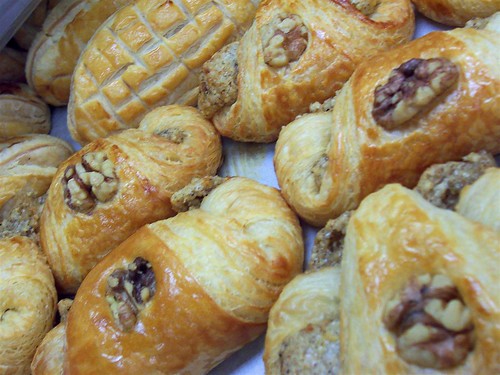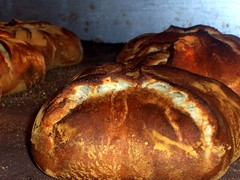Why was I so anxious? There is this thing I do when I really care about something. I become very nervous, So nervous you could freeze butter in my brain --- due to the frigid state I go to. My body screams "code red" & "all hands on deck".
I am so busy with the anxiety that I don't concentrate on what is happening around me in real time.
Ok.
- maybe that is a bit exaggerated (I luv the Seinfeld characters).
Well I had my competency. I had only been in class for 8 days, so I was thinking to myself that the whole thing would be interesting. It was.
We are assigned to groups, one of these members is a 2nd year management student. The others are 2nd quarter students and me. We rotate to different positions in the bakery. Mind you this is a real working production/retail bakery.
We all knew there was a test. And The head instructor , which is from Denmark & a 4th generation baker, is testing us.
Well we draw from scraps of paper what we will be tested on. We go to pull our doughs (we've made the day before) from the reach-in retarder.
No danish dough! There are 4 croissant & 1 puff pastry dough.
We are not supposed to communicate with each other, only the instructor.
But with the dough missing we shoot perplexed glances at each other. Look in the walk-in retarder, the reach-in freezer....we find the danish dough,
rock solid in the walk-in freezer.
I run to his office. HE comes in confirms this. Well now we must work with the croissant dough.
I draw "
plain croissants" ,
Carl says:
"you know he's going to ream you if you don't do them perfectly --- croissants are his thing"
I didn't do too bad I just forgot to add flour to the top of the dough while sheeting...so we couldn't use all of the dough, because the flour is a lubricant. IF not used while sheeting, the sheeter will "eat" it. There were holes in places -- and you want croissant dough intact(for the layers)
I did make about 20 croissants. He said they weren't half bad. (
I am thanking god right then, because this was only my second time making them).
HE told me to help Suzie. She was scaling out ingredients for Danish dough with a starter. She had everything except the ice water. I got that. We put the fresh yeast and water, and the pieces of ascorbic acid into the 40qt mixing bowl and I hand whisked it, with a wire whisk. We added the dry ingredients. The Hobart was going at 1st speed. Oops , the mixer looked like cookie dough. Suzie forgot the starter, which had been fermenting in the walk-in retarder over night. We added the started but he mixer was too dry and it wasn't congealing, the first mixture was mixed into the starter in big chunks. There was no way to save the dough.We had to throw it out.
Turns out we all screwed up in some form or another. The Instructor even commented that :
"today when you woke up you guys should have went back to bed"
He was chuckling though.
When it was my turn to go into the office. He commented on my croissants. And they weren't that bad. He also said that right now I am along for the ride, by next quarter I will be in the groove of things.
SO after I walked out of there I realized I would do alright. I am no longer anxious, I just want to do well.






























